Мир М.Афзал Атлас клинического диагноза
Подождите немного. Документ загружается.

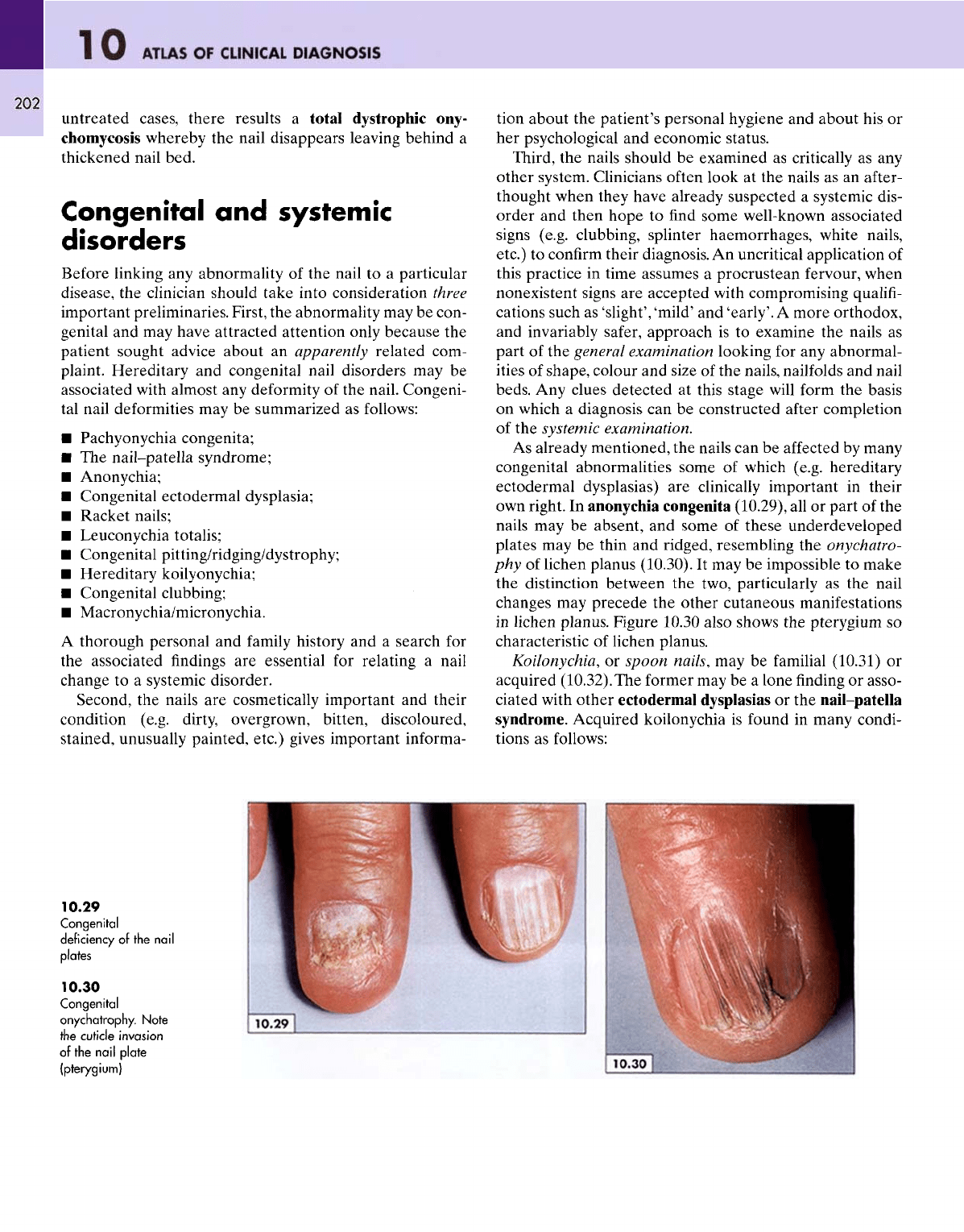
10
ATLAS
OF
CLINICAL
DIAGNOSIS
202
untreated cases, there results
a
total dystrophic
ony-
chomycosis whereby
the
nail disappears leaving behind
a
thickened nail bed.
Congenital
and
systemic
disorders
Before
linking
any
abnormality
of the
nail
to a
particular
disease,
the
clinician should take
into
consideration three
important
preliminaries. First,
the
abnormality
may be
con-
genital
and may
have attracted attention only because
the
patient sought advice about
an
apparently
related com-
plaint. Hereditary
and
congenital nail
disorders
may be
associated with almost
any
deformity
of the
nail. Congeni-
tal
nail deformities
may be
summarized
as
follows:
Pachyonychia
congenita;
The
nail-patella
syndrome;
Anonychia;
Congenital ectodermal dysplasia;
Racket nails;
Leuconychia
totalis;
Congenital pitting/ridging/dystrophy;
Hereditary koilyonychia;
Congenital clubbing;
Macronychia/micronychia.
A
thorough personal
and
family
history
and a
search
for
the
associated
findings
are
essential
for
relating
a
nail
change
to a
systemic disorder.
Second,
the
nails
are
cosmetically important
and
their
condition (e.g. dirty, overgrown, bitten, discoloured,
stained, unusually painted, etc.) gives important informa-
tion
about
the
patient's personal hygiene
and
about
his
or
her
psychological
and
economic status.
Third,
the
nails should
be
examined
as
critically
as any
other system. Clinicians
often
look
at the
nails
as an
after-
thought when they have already suspected
a
systemic dis-
order
and
then
hope
to find
some well-known associated
signs
(e.g. clubbing, splinter haemorrhages, white nails,
etc.)
to
confirm their diagnosis.
An
uncritical application
of
this
practice
in
time assumes
a
procrustean
fervour,
when
nonexistent
signs
are
accepted
with compromising
qualifi-
cations such
as
'slight',
'mild'
and
'early'.
A
more orthodox,
and
invariably safer, approach
is to
examine
the
nails
as
part
of the
general examination looking
for any
abnormal-
ities
of
shape,
colour
and
size
of the
nails,
nailfolds
and
nail
beds.
Any
clues detected
at
this stage
will
form
the
basis
on
which
a
diagnosis
can be
constructed
after
completion
of
the
systemic examination.
As
already mentioned,
the
nails
can be
affected
by
many
congenital abnormalities some
of
which (e.g. hereditary
ectodermal dysplasias)
are
clinically
important
in
their
own
right.
In
anonychia congenita (10.29),
all or
part
of the
nails
may be
absent,
and
some
of
these
underdeveloped
plates
may be
thin
and
ridged, resembling
the
onychatro-
phy
of
lichen planus (10.30).
It may be
impossible
to
make
the
distinction between
the
two, particularly
as the
nail
changes
may
precede
the
other cutaneous manifestations
in
lichen planus.
Figure
10.30
also
shows
the
pterygium
so
characteristic
of
lichen planus.
Koilonychia,
or
spoon
nails,
may be
familial
(10.31)
or
acquired (10.32).
The
former
may be a
lone
finding or
asso-
ciated with other ectodermal
dysplasias
or the
nail-patella
syndrome.
Acquired koilonychia
is
found
in
many condi-
tions
as
follows:
10.29
Congenital
deficiency
of the
nail
plates
10.30
Congenital
onychatrophy.
Note
the
cuticle
invasion
of
the
nail
plate
(pterygium)
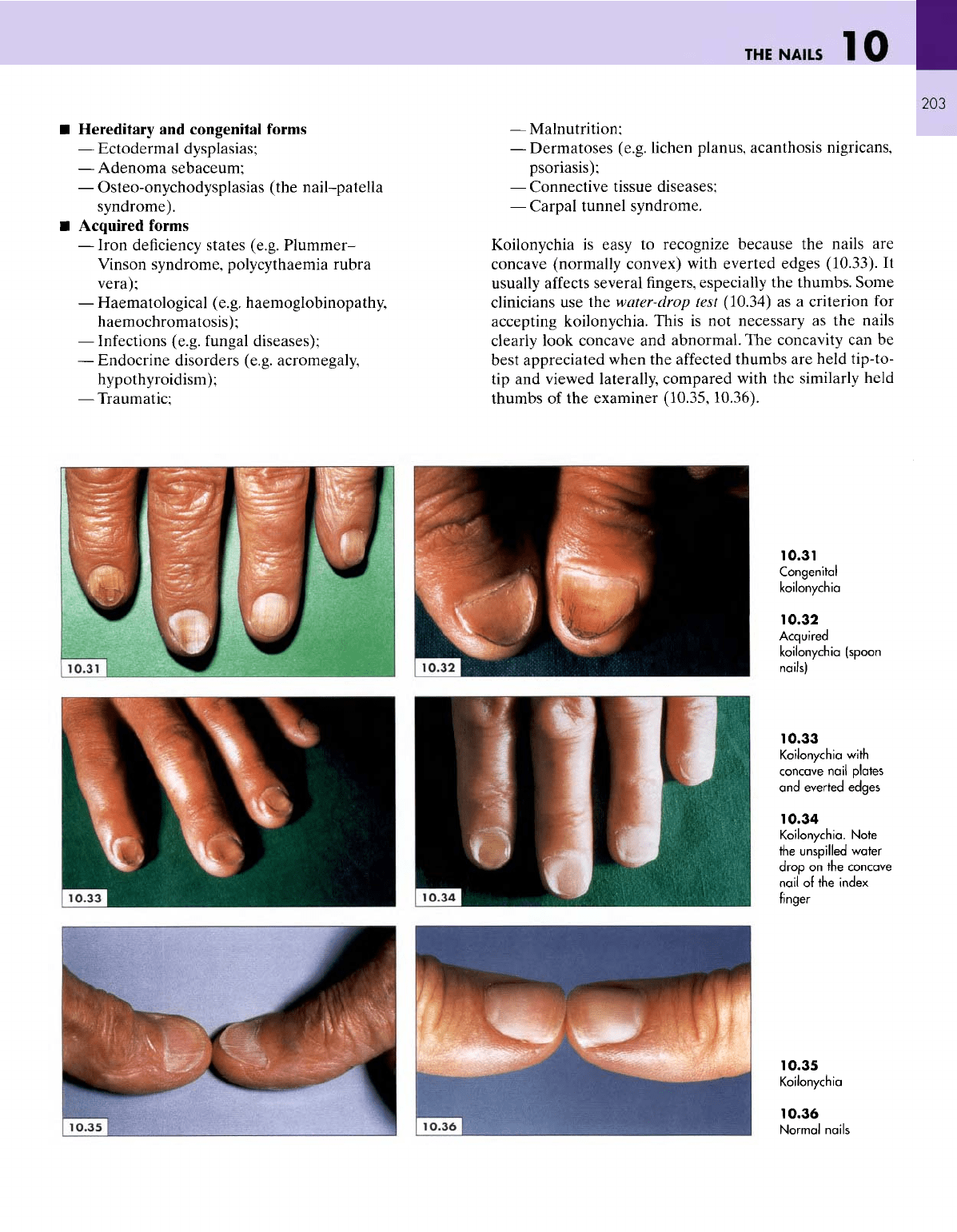
THE
NAILS
Hereditary
and
congenital forms
—
Ectodermal dysplasias;
—
Adenoma
sebaceum;
—
Osteo-onychodysplasias
(the nail-patella
syndrome).
Acquired
forms
—
Iron deficiency states (e.g.
Plummer-
Vinson syndrome, polycythaemia rubra
vera);
—
Haematological (e.g. haemoglobinopathy,
haemochromatosis);
—
Infections (e.g.
fungal
diseases);
—
Endocrine disorders (e.g. acromegaly,
hypothyroidism);
—
Traumatic;
—
Malnutrition;
—
Dermatoses (e.g. lichen planus,
acanthosis
nigricans,
psoriasis);
—
Connective tissue diseases;
—
Carpal tunnel syndrome.
Koilonychia
is
easy
to
recognize because
the
nails
are
concave (normally convex) with everted edges (10.33).
It
usually
affects
several fingers, especially
the
thumbs.
Some
clinicians
use the
water-drop test (10.34)
as a
criterion
for
accepting koilonychia. This
is not
necessary
as the
nails
clearly look concave
and
abnormal.
The
concavity
can be
best appreciated when
the
affected
thumbs
are
held tip-to-
tip and
viewed laterally, compared with
the
similarly held
thumbs
of the
examiner
(10.35,10.36).
10.31
Congenital
koilonychia
10.32
Acquired
koilonychia
(spoon
nails)
10.33
Koilonychia
with
concave
nail
plates
and
everted edges
10.34
Koilonychia.
Note
the
unspilled
water
drop
on the
concave
nail
of the
index
finger
10.35
Koilonychia
10.36
Normal
nails
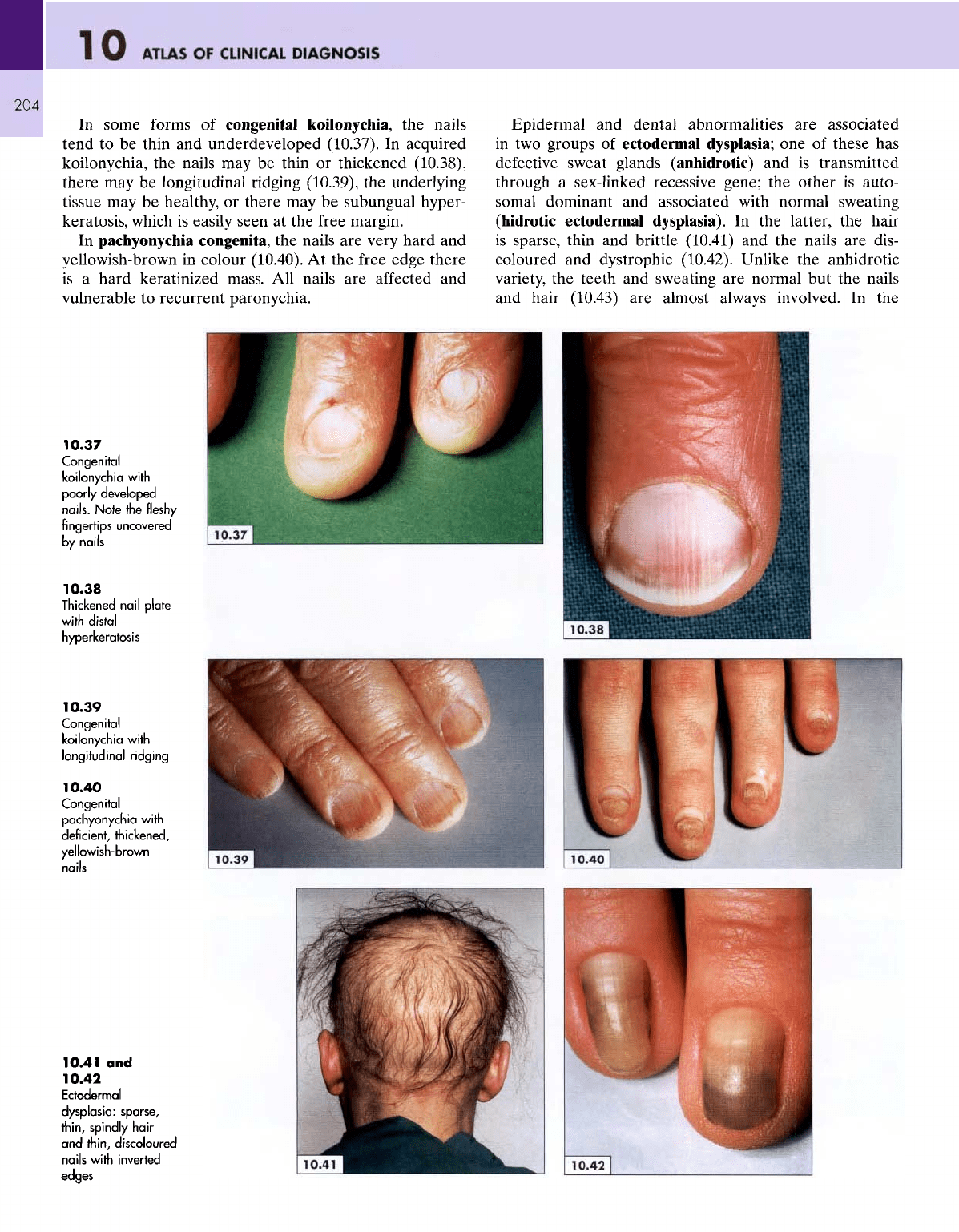
10
ATLAS
OF
CLINICAL
DIAGNOSIS
In
some forms
of
congenital koilonychia,
the
nails
tend
to be
thin
and
underdeveloped (10.37).
In
acquired
koilonychia,
the
nails
may be
thin
or
thickened (10.38),
there
may be
longitudinal ridging (10.39),
the
underlying
tissue
may be
healthy,
or
there
may be
subungual hyper-
keratosis,
which
is
easily seen
at the
free
margin.
In
pachyonychia congenita,
the
nails
are
very hard
and
yellowish-brown
in
colour (10.40).
At the
free
edge
there
is
a
hard keratinized mass.
All
nails
are
affected
and
vulnerable
to
recurrent
paronychia.
Epidermal
and
dental abnormalities
are
associated
in
two
groups
of
ectodermal
dysplasia;
one of
these
has
defective
sweat glands (anhidrotic)
and is
transmitted
through
a
sex-linked recessive gene;
the
other
is
auto-
somal
dominant
and
associated with normal sweating
(hidrotic
ectodermal
dysplasia).
In the
latter,
the
hair
is
sparse, thin
and
brittle
(10.41)
and the
nails
are
dis-
coloured
and
dystrophic (10.42). Unlike
the
anhidrotic
variety,
the
teeth
and
sweating
are
normal
but the
nails
and
hair (10.43)
are
almost
always
involved.
In the
10.37
Congenital
koilonychia
with
poorly
developed
nails.
Note
the
fleshy
fingertips uncovered
by
nails
10.38
Thickened
nail
plate
with
distal
hyperkeratosis
10.39
Congenital
koilonychia
with
longitudinal
ridging
10.40
Congenital
pachyonychia
with
deficient, thickened,
yellowish-brown
10.41
and
10.42
Ectodermal
dysplasia:
sparse,
thin,
spindly
hair
and
thin,
discoloured
nails
with
inverted
edges
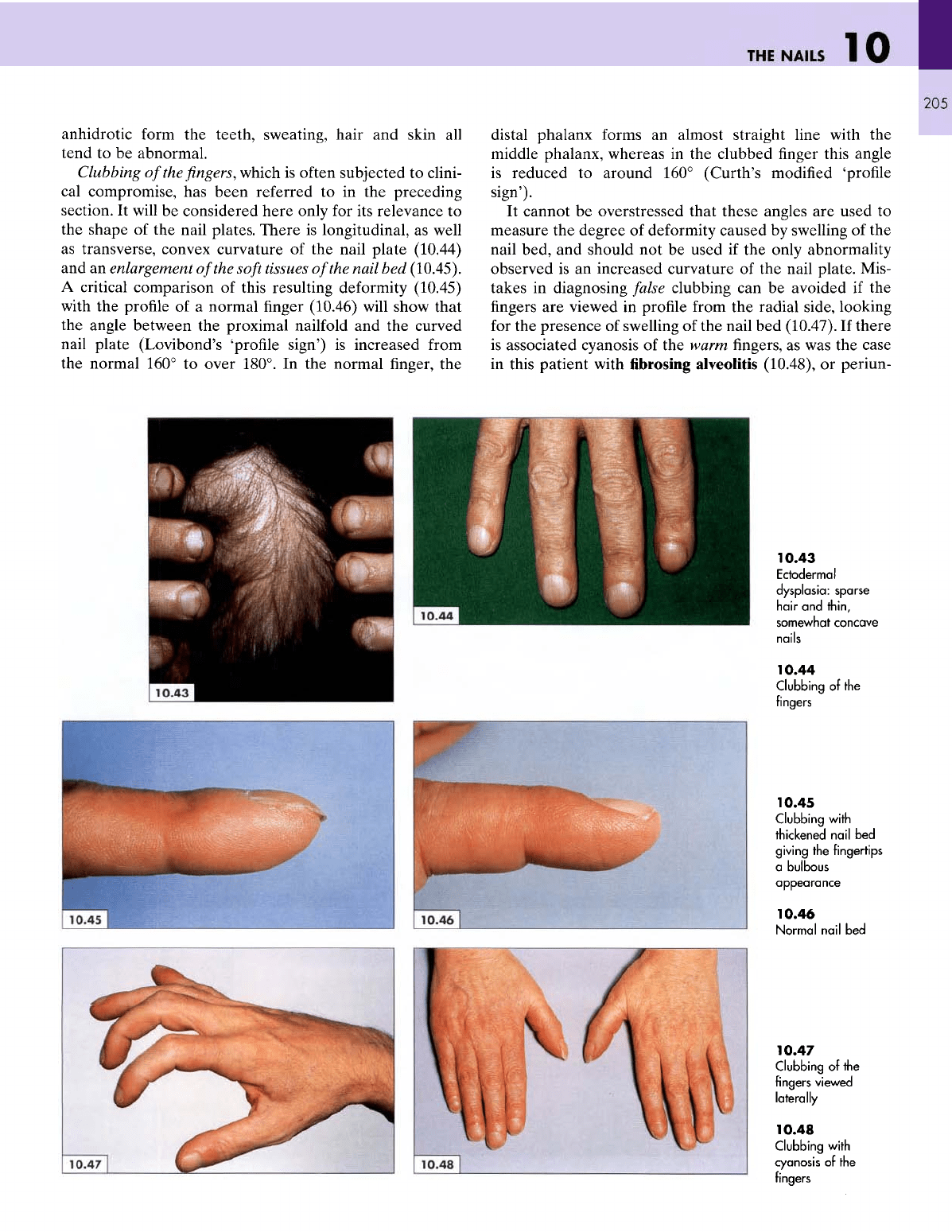
THE
NAILS
•
'
-^^^j^^^^^m
10
1
anhidrotic form
the
teeth, sweating, hair
and
skin
all
tend
to be
abnormal.
Clubbing
of the fingers,
which
is
often subjected
to
clini-
cal
compromise,
has
been referred
to in the
preceding
section.
It
will
be
considered here only
for its
relevance
to
the
shape
of the
nail plates.
There
is
longitudinal,
as
well
as
transverse, convex curvature
of the
nail plate (10.44)
and an
enlargement
of
the
soft
tissues
of
the
nail
bed
(10.45).
A
critical comparison
of
this resulting deformity (10.45)
with
the
profile
of a
normal finger
(10.46)
will show
that
the
angle between
the
proximal nailfold
and the
curved
nail
plate (Lovibond's
'profile
sign')
is
increased from
the
normal 160°
to
over 180°.
In the
normal
finger, the
distal
phalanx forms
an
almost straight line with
the
middle phalanx, whereas
in the
clubbed
finger
this angle
is
reduced
to
around
160°
(Curth's modified
'profile
sign').
It
cannot
be
overstressed that these angles
are
used
to
measure
the
degree
of
deformity caused
by
swelling
of the
nail
bed,
and
should
not be
used
if the
only abnormality
observed
is an
increased curvature
of the
nail plate. Mis-
takes
in
diagnosing
false
clubbing
can be
avoided
if the
fingers are
viewed
in
profile
from
the
radial side, looking
for
the
presence
of
swelling
of the
nail
bed
(10.47).
If
there
is
associated cyanosis
of the
warm
fingers, as was the
case
in
this patient with
fibrosing
alveolitis
(10.48),
or
periun-
10.43
Ectodermal
dysplasia: sparse
hair
and
thin,
somewhat concave
nails
10.44
Clubbing
of the
fingers
10.45
Clubbing
with
thickened
nail
bed
giving
the
fingertips
a
bulbous
appearance
10.46
Normal
nail
bed
10.47
Clubbing
of the
fingers viewed
laterally
10.48
Clubbing
with
cyanosis
of the
fingers
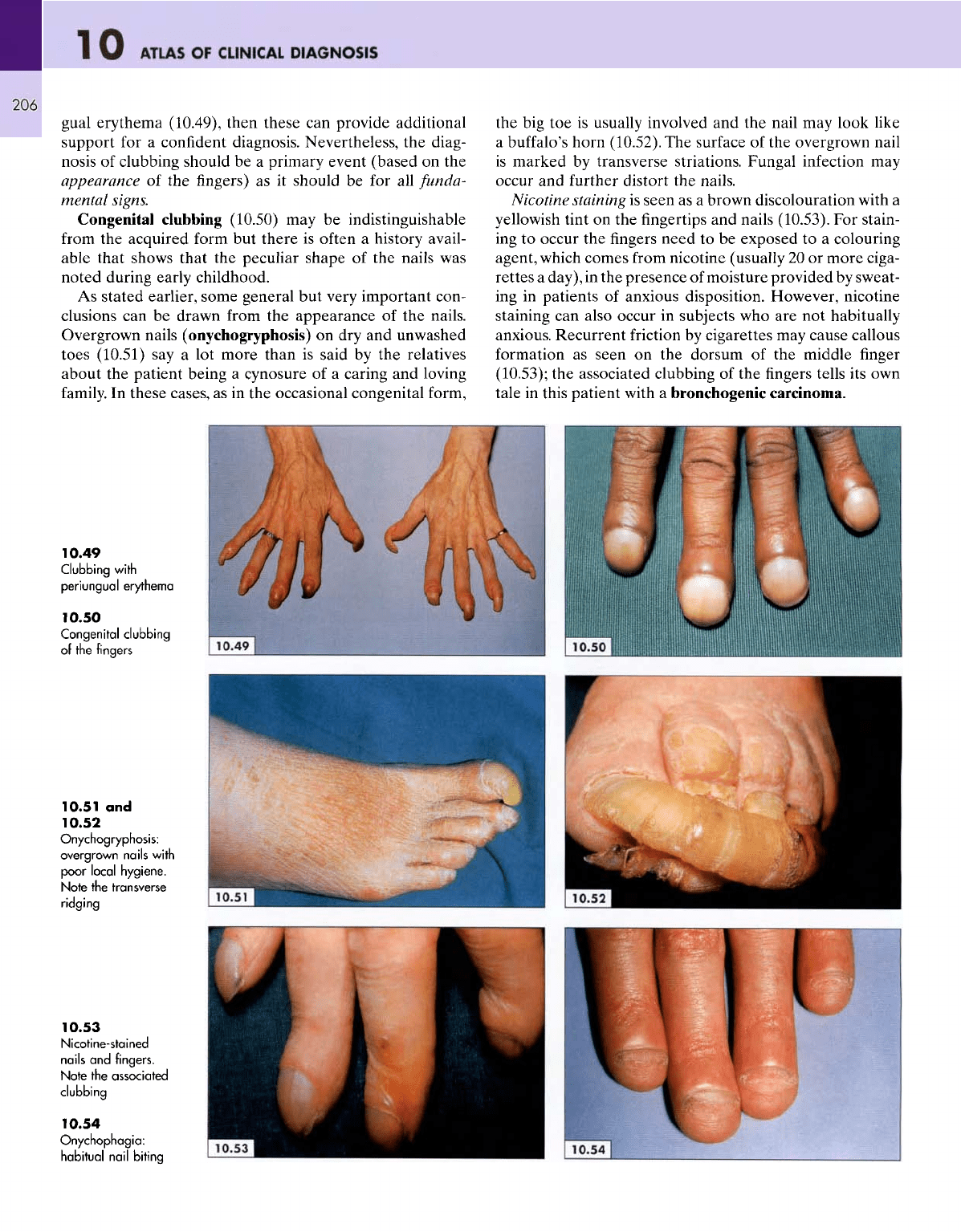
ATLAS
OF
CLINICAL
DIAGNOSIS
gual
erythema (10.49), then these
can
provide additional
support
for a
confident diagnosis. Nevertheless,
the
diag-
nosis
of
clubbing should
be a
primary event (based
on the
appearance
of the
fingers)
as it
should
be for all
funda-
mental signs.
Congenital clubbing (10.50)
may be
indistinguishable
from
the
acquired form
but
there
is
often
a
history
avail-
able
that shows that
the
peculiar shape
of the
nails
was
noted during early childhood.
As
stated earlier, some general
but
very important con-
clusions
can be
drawn
from
the
appearance
of the
nails.
Overgrown nails (onychogryphosis)
on dry and
unwashed
toes
(10.51)
say a lot
more than
is
said
by the
relatives
about
the
patient being
a
cynosure
of a
caring
and
loving
family.
In
these cases,
as in the
occasional congenital form,
the big toe is
usually involved
and the
nail
may
look like
a
buffalo's
horn (10.52).
The
surface
of the
overgrown nail
is
marked
by
transverse striations. Fungal infection
may
occur
and
further
distort
the
nails.
Nicotine staining
is
seen
as a
brown discolouration with
a
yellowish
tint
on the
fingertips
and
nails (10.53).
For
stain-
ing
to
occur
the fingers
need
to be
exposed
to a
colouring
agent, which
comes
from nicotine (usually
20 or
more
ciga-
rettes
a
day),
in the
presence
of
moisture provided
by
sweat-
ing
in
patients
of
anxious disposition. However, nicotine
staining
can
also occur
in
subjects
who are not
habitually
anxious. Recurrent friction
by
cigarettes
may
cause callous
formation
as
seen
on the
dorsum
of the
middle
finger
(10.53);
the
associated clubbing
of the fingers
tells
its own
tale
in
this patient with
a
bronchogenic carcinoma.
10.49
Clubbing
with
periungual
erythema
10.50
Congenital
clubbing
of the
fingers
10.51
and
10.52
Onychogryphosis:
overgrown
nails
with
poor
local
hygiene.
Note
the
transverse
ridging
10.53
Nicotine-stained
nails
and
fingers.
Note
the
associated
clubbing
10.54
Onychophagia:
habitual
nail
biting
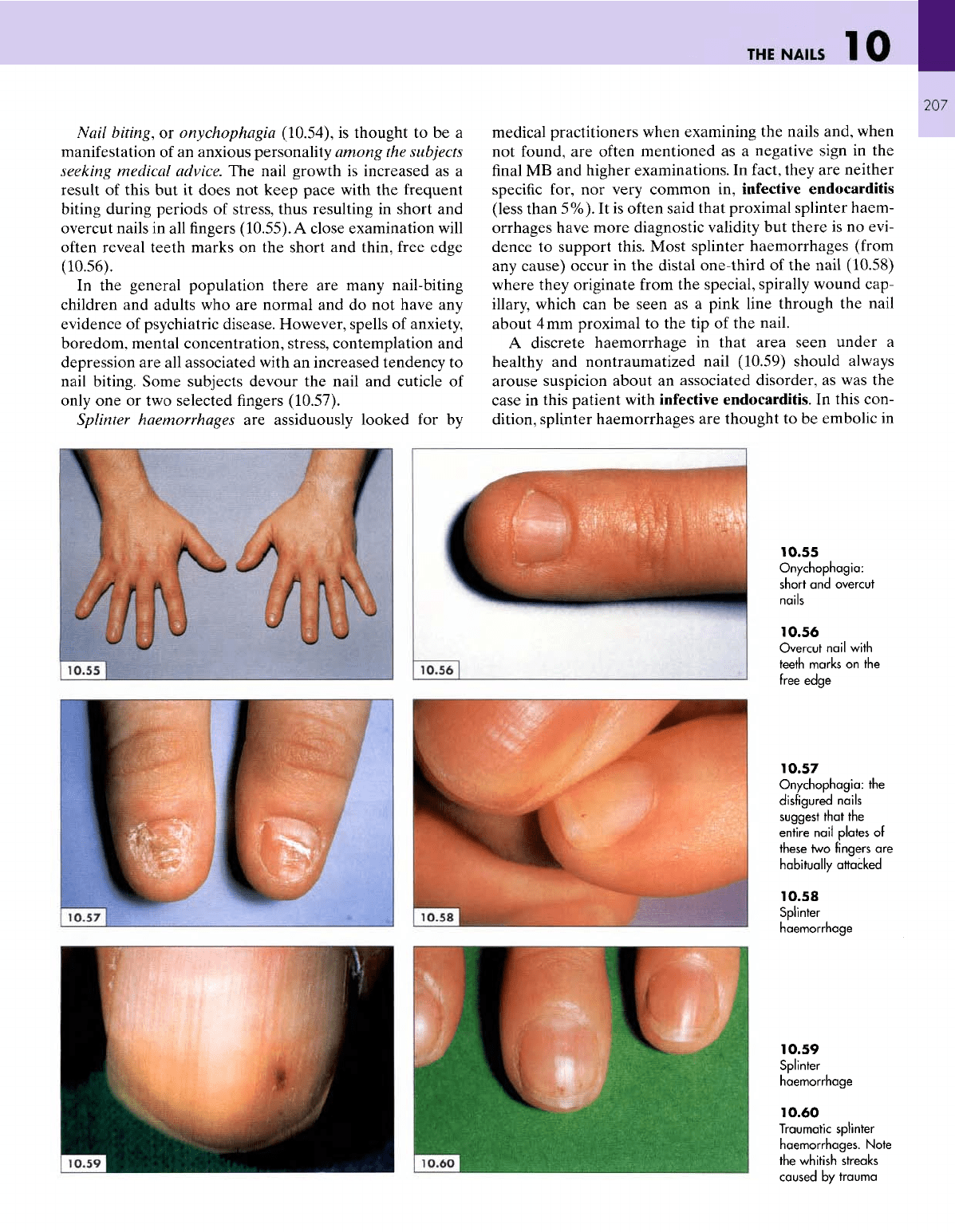
THE
NAILS
Nail
biting,
or
onychophagia
(10.54),
is
thought
to be a
manifestation
of an
anxious personality among
the
subjects
seeking medical advice.
The
nail growth
is
increased
as a
result
of
this
but it
does
not
keep
pace
with
the
frequent
biting
during periods
of
stress, thus resulting
in
short
and
overcut nails
in all
fingers
(10.55).
A
close examination
will
often
reveal teeth marks
on the
short
and
thin, free edge
(10.56).
In
the
general population there
are
many nail-biting
children
and
adults
who are
normal
and do not
have
any
evidence
of
psychiatric disease. However, spells
of
anxiety,
boredom, mental concentration, stress, contemplation
and
depression
are all
associated with
an
increased tendency
to
nail
biting. Some subjects devour
the
nail
and
cuticle
of
only
one or two
selected fingers (10.57).
Splinter
haemorrhages
are
assiduously looked
for by
medical practitioners when examining
the
nails and, when
not
found,
are
often mentioned
as a
negative sign
in the
final MB and
higher examinations.
In
fact,
they
are
neither
specific for,
nor
very common
in,
infective endocarditis
(less
than 5%).
It is
often said that proximal splinter haem-
orrhages have more diagnostic validity
but
there
is no
evi-
dence
to
support this. Most splinter haemorrhages
(from
any
cause)
occur
in the
distal one-third
of the
nail
(10.58)
where they originate from
the
special, spirally wound cap-
illary,
which
can be
seen
as a
pink line through
the
nail
about
4mm
proximal
to the tip of the
nail.
A
discrete haemorrhage
in
that area seen under
a
healthy
and
nontraumatized nail (10.59) should always
arouse suspicion about
an
associated disorder,
as was the
case
in
this patient with infective endocarditis.
In
this con-
dition,
splinter haemorrhages
are
thought
to be
embolic
in
10.55
Onychophagia:
short
and
overcut
nails
10.56
Overcut
nail
with
teeth marks
on the
free
edge
10.57
Onychophagia:
the
disfigured
nails
suggest
that
the
entire
nail
plates
of
these
two
fingers
are
habitually
attacked
10.58
Splinter
haemorrhage
10.59
Splinter
haemorrhage
10.60
Traumatic
splinter
haemorrhages.
Note
the
whitish streaks
caused
by
trauma
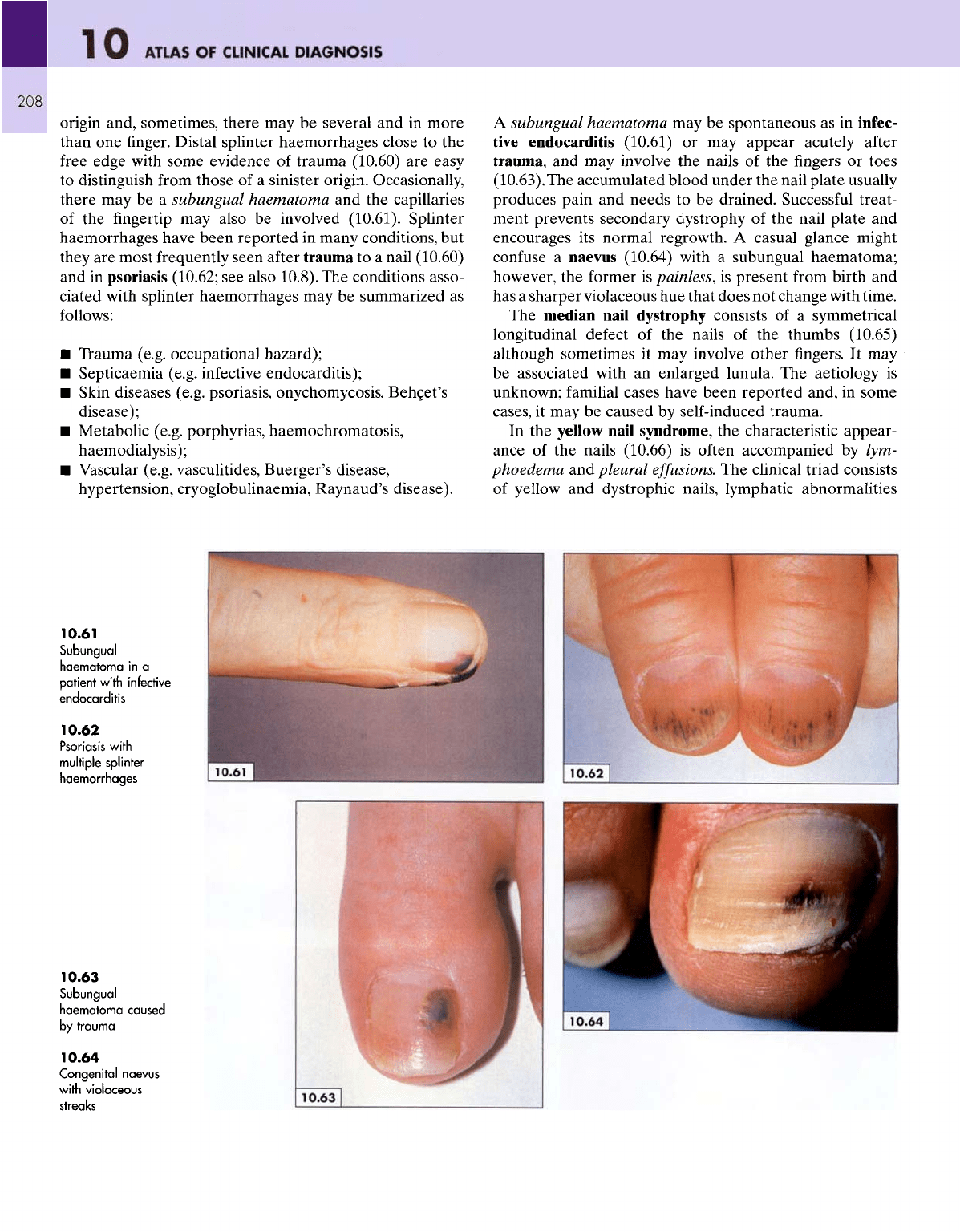
10
ATLAS
OF
CLINICAL
DIAGNOSIS
208
origin
and, sometimes, there
may be
several
and in
more
than
one
finger.
Distal splinter haemorrhages close
to the
free
edge with some evidence
of
trauma
(10.60)
are
easy
to
distinguish
from
those
of a
sinister origin. Occasionally,
there
may be a
subungual
haematoma
and the
capillaries
of
the
fingertip
may
also
be
involved
(10.61).
Splinter
haemorrhages have been reported
in
many conditions,
but
they
are
most frequently seen
after
trauma
to a
nail (10.60)
and
in
psoriasis (10.62;
see
also 10.8).
The
conditions asso-
ciated with splinter haemorrhages
may be
summarized
as
follows:
•
Trauma (e.g. occupational hazard);
•
Septicaemia (e.g.
infective
endocarditis);
•
Skin diseases (e.g. psoriasis, onychomycosis,
Behcet's
disease);
•
Metabolic (e.g. porphyrias, haemochromatosis,
haemodialysis);
•
Vascular (e.g. vasculitides, Buerger's disease,
hypertension, cryoglobulinaemia, Raynaud's disease).
A
subungual haematoma
may be
spontaneous
as in
infec-
tive
endocarditis (10.61)
or may
appear acutely
after
trauma,
and may
involve
the
nails
of the
fingers
or
toes
(10.63).The
accumulated blood under
the
nail plate usually
produces pain
and
needs
to be
drained. Successful treat-
ment prevents secondary dystrophy
of the
nail plate
and
encourages
its
normal regrowth.
A
casual glance might
confuse
a
naevus (10.64) with
a
subungual haematoma;
however,
the
former
is
painless,
is
present
from
birth
and
has a
sharper violaceous
hue
that does
not
change with time.
The
median nail dystrophy consists
of a
symmetrical
longitudinal
defect
of the
nails
of the
thumbs (10.65)
although
sometimes
it may
involve
other
fingers.
It may
be
associated with
an
enlarged lunula.
The
aetiology
is
unknown;
familial
cases have been reported and,
in
some
cases,
it may be
caused
by
self-induced trauma.
In the
yellow nail syndrome,
the
characteristic appear-
ance
of the
nails (10.66)
is
often accompanied
by
lym-
phoedema
and
pleural
effusions.
The
clinical triad consists
of
yellow
and
dystrophic nails, lymphatic abnormalities
10.61
Subungual
haematoma
in a
patient
with
infective
endocarditis
10.62
Psoriasis
with
multiple
splinter
haemorrhages
10.63
Subungual
haematoma
caused
by
trauma
10.64
Congenital
naevus
with violaceous
streaks
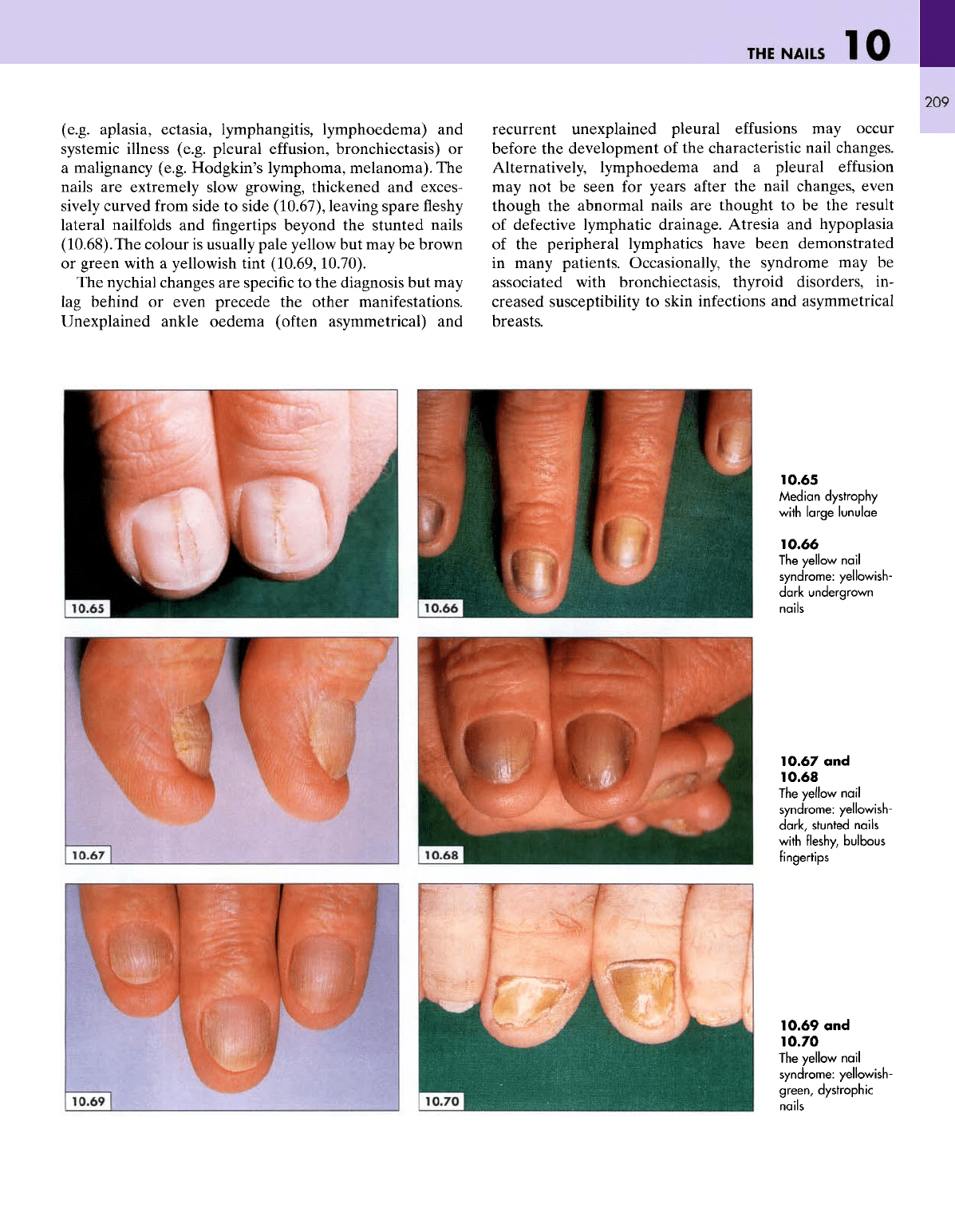
THE
NAILS
1
209
(e.g. aplasia, ectasia, lymphangitis, lymphoedema)
and
systemic illness (e.g. pleural
effusion,
bronchiectasis)
or
a
malignancy (e.g. Hodgkin's
lymphoma,
melanoma).
The
nails
are
extremely slow growing, thickened
and
exces-
sively
curved
from
side
to
side (10.67), leaving spare
fleshy
lateral
nailfolds
and
fingertips
beyond
the
stunted nails
(10.68).The
colour
is
usually pale yellow
but may be
brown
or
green with
a
yellowish tint
(10.69,10.70).
The
nychial changes
are
specific
to the
diagnosis
but may
lag
behind
or
even precede
the
other manifestations.
Unexplained ankle oedema
(often
asymmetrical)
and
recurrent unexplained pleural
effusions
may
occur
before
the
development
of the
characteristic nail changes.
Alternatively,
lymphoedema
and a
pleural
effusion
may
not be
seen
for
years
after
the
nail changes, even
though
the
abnormal nails
are
thought
to be the
result
of
defective lymphatic drainage. Atresia
and
hypoplasia
of
the
peripheral lymphatics have been demonstrated
in
many patients. Occasionally,
the
syndrome
may be
associated
with
bronchiectasis, thyroid disorders,
in-
creased susceptibility
to
skin infections
and
asymmetrical
breasts.
10.65
Median
dystrophy
with
large
lunulae
10.66
The
yellow
nail
syndrome: yellowish-
dark
undergrown
nails
10.67
and
10.68
The
yellow
nail
syndrome:
yellowish-
dark,
stunted nails
with
fleshy, bulbous
fingertips
10.69
and
10.70
The
yellow
nail
syndrome:
yellowish-
green,
dystrophic
nails
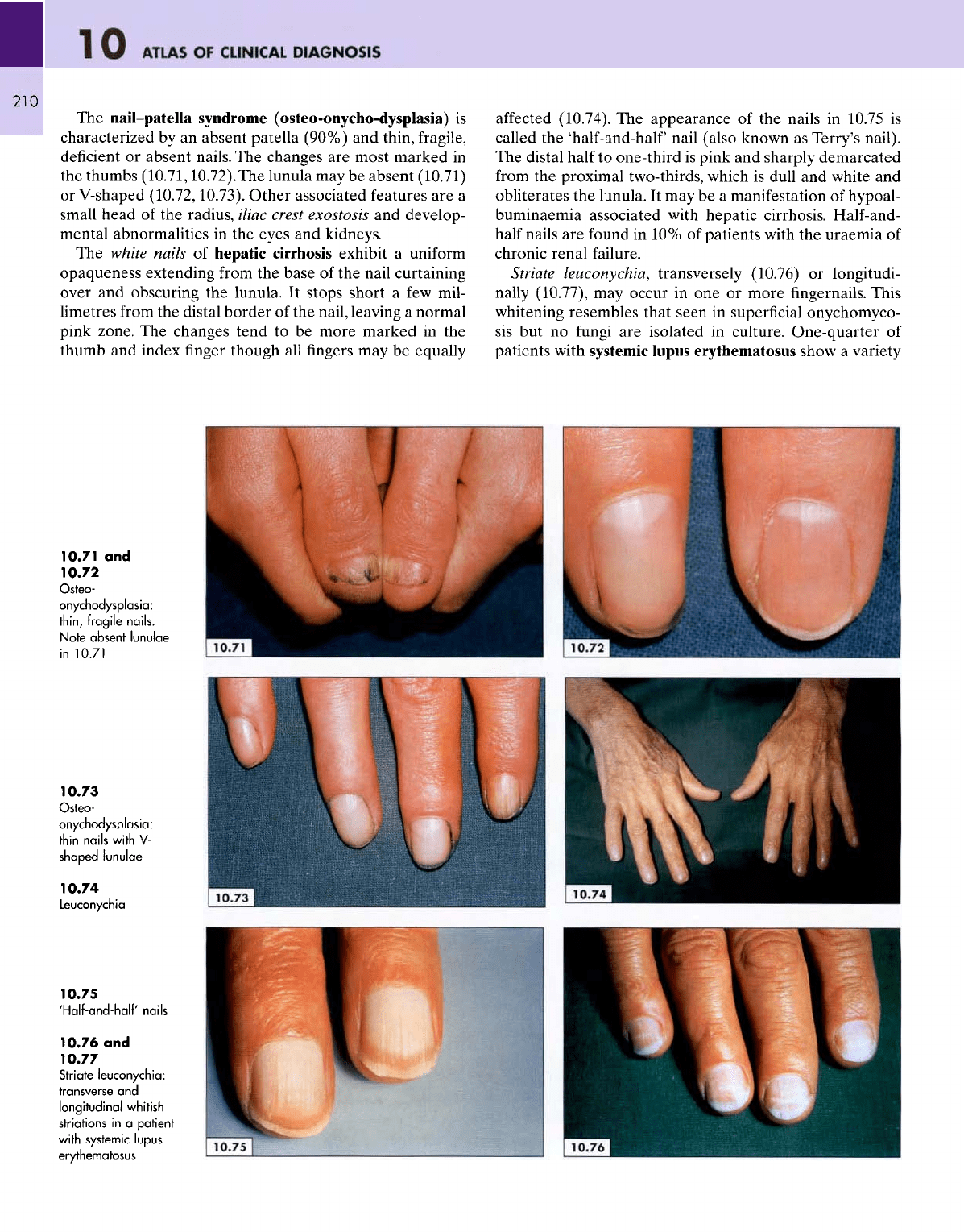
10
ATLAS
OF
CLINICAL
DIAGNOSIS
210
The
nail-patella syndrome
(osteo-onycho-dysplasia)
is
characterized
by an
absent patella (90%)
and
thin,
fragile,
deficient
or
absent nails.
The
changes
are
most marked
in
the
thumbs
(10.71,10.72).The
lunula
may be
absent (10.71)
or
V-shaped
(10.72,10.73).
Other associated features
are a
small
head
of the
radius, iliac crest exostosis
and
develop-
mental abnormalities
in the
eyes
and
kidneys.
The
white nails
of
hepatic cirrhosis exhibit
a
uniform
opaqueness extending
from
the
base
of the
nail curtaining
over
and
obscuring
the
lunula.
It
stops
short
a few
mil-
limetres
from
the
distal border
of the
nail, leaving
a
normal
pink
zone.
The
changes tend
to be
more marked
in the
thumb
and
index
finger
though
all
fingers
may be
equally
affected
(10.74).
The
appearance
of the
nails
in
10.75
is
called
the
'half-and-half
nail (also known
as
Terry's nail).
The
distal half
to
one-third
is
pink
and
sharply demarcated
from
the
proximal two-thirds, which
is
dull
and
white
and
obliterates
the
lunula.
It may be a
manifestation
of
hypoal-
buminaemia associated with hepatic cirrhosis. Half-and-
half
nails
are
found
in 10% of
patients with
the
uraemia
of
chronic renal failure.
Striate
leuconychia,
transversely (10.76)
or
longitudi-
nally (10.77),
may
occur
in one or
more
fingernails. This
whitening
resembles that seen
in
superficial
onychomyco-
sis
but no
fungi
are
isolated
in
culture. One-quarter
of
patients with systemic lupus erythematosus show
a
variety
10.71
and
10.72
Osteo-
onychodysplasia:
thin,
fragile
nails.
Note
absent
lunulae
in
10.71
10.73
Osteo-
onychodysplasia:
thin nails
with
V-
shaped
lunulae
10.74
Leuconychia
10.75
'Half-and-half'
nails
10.76
and
10.77
Striate
leuconychia:
transverse
and
longitudinal
whitish
striations
in a
patient
with
systemic lupus
erythematosus
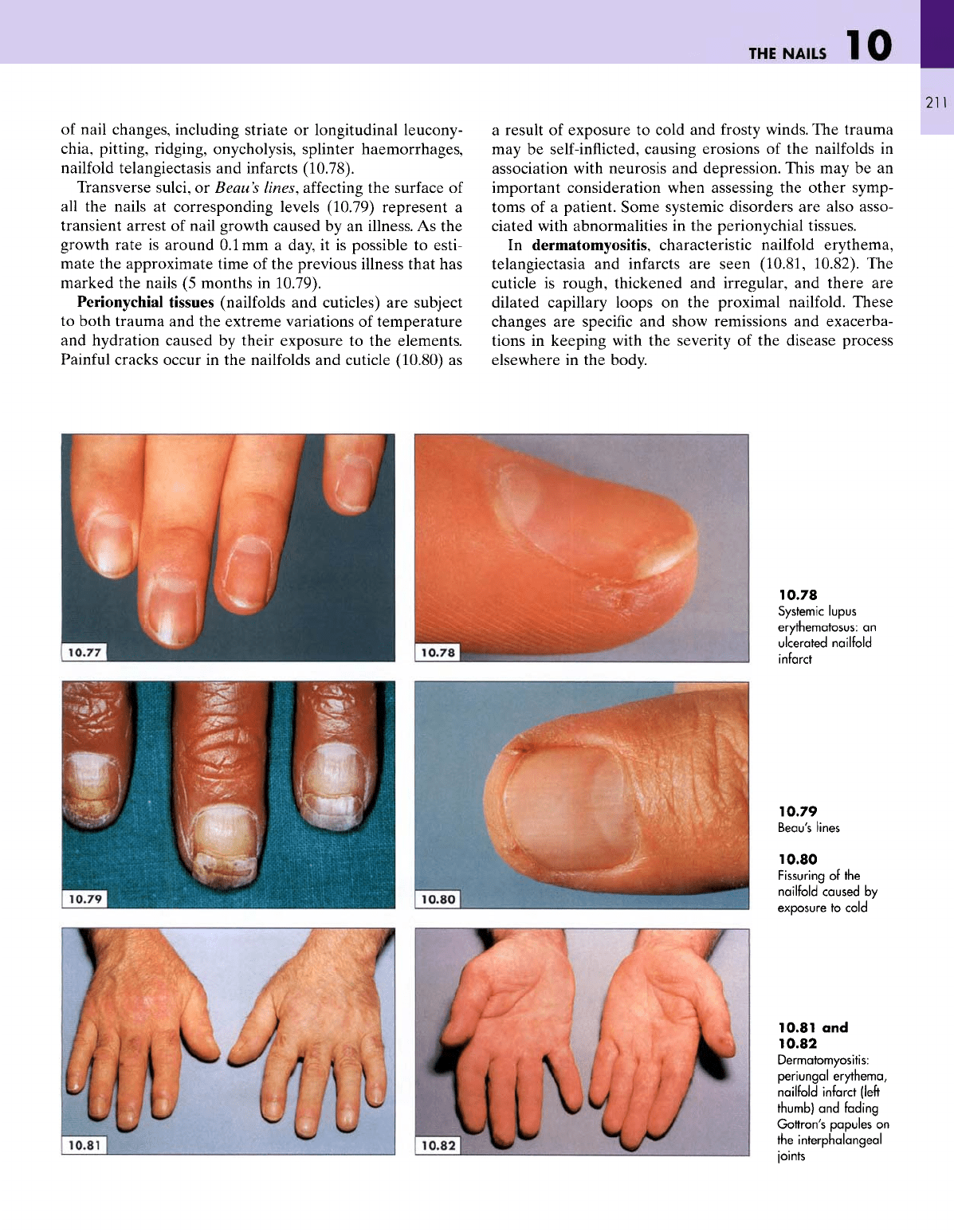
THE
NAILS
211
of
nail changes, including striate
or
longitudinal leucony-
chia,
pitting, ridging, onycholysis, splinter haemorrhages,
nailfold
telangiectasis
and
infarcts (10.78).
Transverse
sulci,
or
Beau's
lines,
affecting
the
surface
of
all
the
nails
at
corresponding levels (10.79) represent
a
transient arrest
of
nail growth caused
by an
illness.
As the
growth
rate
is
around
O.lmm
a
day,
it is
possible
to
esti-
mate
the
approximate time
of the
previous illness that
has
marked
the
nails
(5
months
in
10.79).
Perionychial
tissues
(nailfolds
and
cuticles)
are
subject
to
both
trauma
and the
extreme variations
of
temperature
and
hydration caused
by
their exposure
to the
elements.
Painful
cracks occur
in the
nailfolds
and
cuticle
(10.80)
as
a
result
of
exposure
to
cold
and
frosty
winds.
The
trauma
may be
self-inflicted,
causing erosions
of the
nailfolds
in
association with neurosis
and
depression. This
may be an
important consideration when assessing
the
other symp-
toms
of a
patient. Some systemic disorders
are
also asso-
ciated with abnormalities
in the
perionychial tissues.
In
dermatomyositis, characteristic
nailfold
erythema,
telangiectasia
and
infarcts
are
seen (10.81, 10.82).
The
cuticle
is
rough, thickened
and
irregular,
and
there
are
dilated capillary loops
on the
proximal nailfold.
These
changes
are
specific
and
show remissions
and
exacerba-
tions
in
keeping with
the
severity
of the
disease process
elsewhere
in the
body.
10.78
Systemic lupus
erythematosus:
an
ulcerated
nailfold
infarct
10.79
Beau's
lines
10.80
Fissuring
of the
nailfold
caused
by
exposure
to
cold
10.81
and
10.82
Dermatomyositis:
periungal
erythema,
nailfold
infarct
(left
thumb)
and
fading
Gottron's
papules
on
the
interphalangeal
joints
